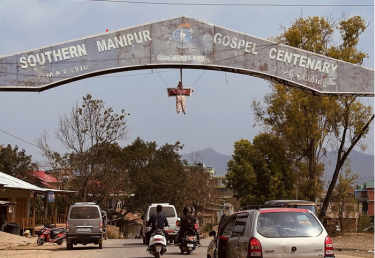
In a region often characterized by religious tensions, Tamenglong district in Manipur stands as a remarkable example of communal harmony, where diverse religious communities coexist peacefully despite their differences.
The Christian-majority district houses a significant Hindu minority population that practices its faith without fear or discrimination. At the centre of this interfaith harmony is the Kali Mata Temple, which has become not just a place of worship for Hindus but a symbol of the district’s inclusive spirit.
“Despite tension, all communities live peacefully. Many different communities are here; you might have seen a Hindu temple. Hindus are a minority, but we don’t disturb them,” explains Kadi Kamei, Deacon of the Zeliangrong Baptist Church, highlighting the mutual respect that underpins the district’s peaceful environment.
The peaceful coexistence extends beyond mere tolerance to active participation in each other’s religious celebrations. From Christmas to Durga Puja and Eid, festivals of every faith are celebrated with collective enthusiasm, embodying the spirit of unity that permeates the district.
Sanjay Jha, a Hindu priest at the Kali Mata Temple, attests to this harmony: “We are all living among the local Christians. The local people have never disturbed this temple. We always support everyone during important festivals.”
This sentiment is echoed by Bhim Prasad Koirala, a local teacher, who confirms, “There is no conflict between Hindus and Christians here, and the temple is also running well.”
The district’s approach to religious diversity offers a hopeful alternative to the communal discord that often makes headlines elsewhere. In Tamenglong, religious differences are not seen as barriers but as enriching aspects of a shared community life.
Rathailung Gangmei, Youth Director of Tamenglong Baptist Church, expresses pride in the district’s achievement: “We are happy that we are peaceful. There are so many communities, so many ethnicities and religions, like Hindus, Christians, and Muslims. We are living peacefully here.”
What makes Tamenglong’s example particularly relevant is that peace isn’t maintained through special programs or interventions but through everyday interactions characterized by respect and understanding. Residents don’t view their diversity as something to overcome but as something to celebrate.
The regular presence of Hindu devotees at the temple of the goddess Kali, free from fear of discrimination, demonstrates the practical reality of this harmony. Similarly, Christian churches operate without any sense of dominance despite being in the majority.
Observers note that Tamenglong’s success lies in its understanding that harmony doesn’t require sameness but rather shared humanity. The district proves that people of different faiths can maintain their distinct religious identities while fostering strong community bonds.
In a world where religious differences often lead to division, Tamenglong offers an instructive counterexample - a community where religion serves as a bridge rather than a barrier. Through mutual respect and peaceful coexistence, the residents of this district have created a sustainable model of communal harmony that transforms diversity from a potential source of conflict into a strength.
As one resident aptly put it, in Tamenglong, “peace isn’t just an aspiration - it’s a reality crafted and nurtured daily by its people.”
This report is based on coverage by Asian News International (ANI).




